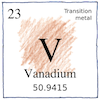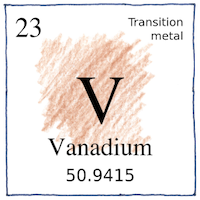Mexico City, Stockholm, Manchester—Andrés Manuel del Río,
Nils Gabriel Sefström,
Jöns Jacob Berzelius,
Henry Enfield Roscoe
elements

|
Vanadium
Andrés Manuel del Río extracted the salts of a new metal from brown lead from Zimapán and named it panchromium. Alexander von Humboldt took samples from del Río to Hippolyte Victor Collet-Descotils who wrongly said it was only chromium. Nils Gabriel Sefström took a ductile iron ore from Taberg used since 1621 to make rifles to Jöns Jacob Berzelius. Together, Sefström and Berzelius rediscovered the new metal, although they isolated it only as a nitride, and they named it vanadium. Henry Enfield Roscoe was the first to isolate the pure metal, although large-scale production would take another fifty years.
Atomic number 23
Vanadium steels stronger and lighter for chassis and gears of Ford’s Model T for surgical instruments, tools, and knives * Vanadium pentoxide catalyzes sulfuric acid. Vanadium dioxide blocks infrared light.
Stuff with color
Pigment, as from chromium or vanadium, is subtractive. Light, as from prisms or rainbows, is additive. Red and yellow, black and white, people are like light.



Henry Enfield Roscoe was the uncle of Beatrix Potter. Aside from that, he was the first to isolate pure vanadium metal.
Pigments absorb all but the color they reflect; mix them together to absorb all colors. When you mix cyan, magenta, and yellow pigments, you get black. When you overlap red, blue, and green lights, you get white. Isaac Newton recombined colors from a prism back into white light with another prism to show that color was a property of light.
See also in The book of science:
Readings in wikipedia:
Other readings: